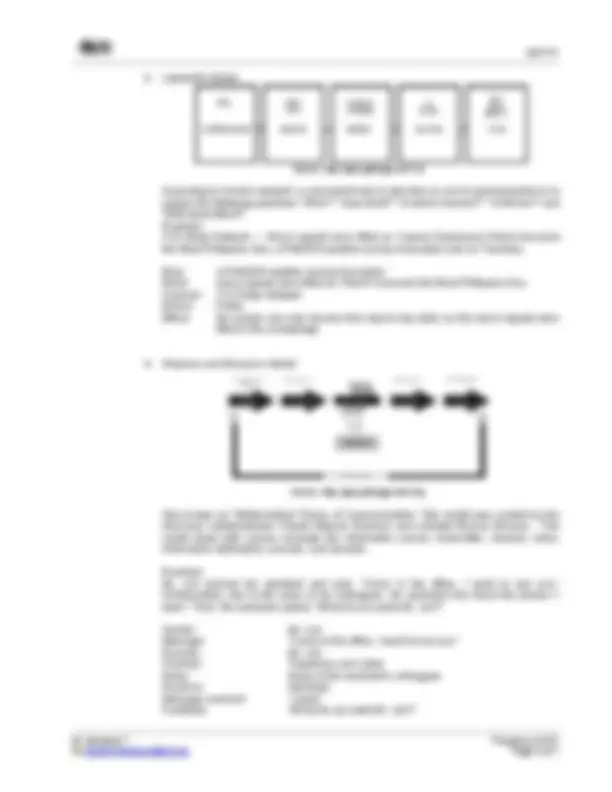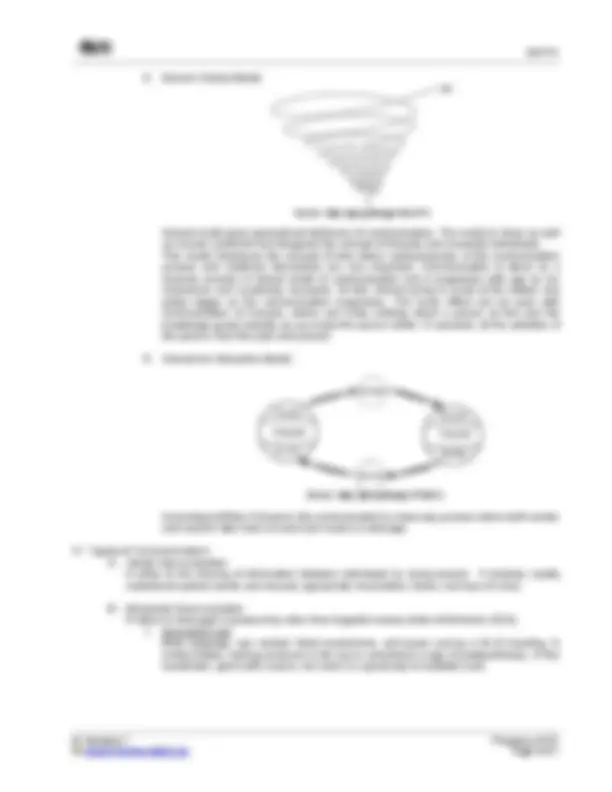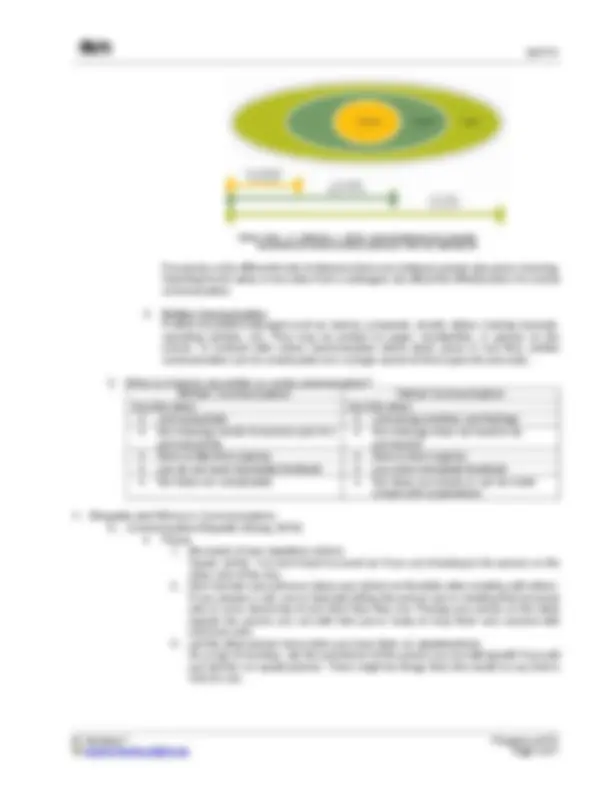





Study with the several resources on Docsity

Earn points by helping other students or get them with a premium plan


Prepare for your exams
Study with the several resources on Docsity

Earn points to download
Earn points by helping other students or get them with a premium plan
Community
Ask the community for help and clear up your study doubts
Discover the best universities in your country according to Docsity users
Free resources
Download our free guides on studying techniques, anxiety management strategies, and thesis advice from Docsity tutors
Handout for 1st year college Purposive Communication
Typology: Summaries
1 / 7

This page cannot be seen from the preview
Don't miss anything!




01 Handout 1 _Property of STI_*
Communication Processes, Principles, and Ethics
I. Definition of Communication
II. Communication Principles (Adler & Elmhorst, 2012) A. Communication is unavoidable It is impossible for a person not to communicate. Our facial expression, posture, gesture, clothing, etc. offer cues about our attitude. Interestingly, even absence has a power to imply a message. Because of this principle, it is important to consider the unintentional message you send. B. Communication operates on two levels There are two (2) kinds of messages that is sent every time people communicate. First are the content messages or the information about the topic under discussion. Second, is the relational messages or signals that indicates how a person feels about one (1) another. There are three types of relational message: (1) affinity , which refers to the degree to which a communicator likes the other person or a particular message that is being sent; (2) control , or the amount of influence in that situation; and lastly (3) respect for other person. C. Communication is irreversible You could not take back words you regretted uttering because our words and deeds are recorded in others’ memories. The more you try to erase an act, the more it stands out. D. Communication is a process You should not view communication as if sending and receiving a message were an isolated event. Rather, ever communication event needs to be examined as part of its communication context. E. Communication is not a panacea Though it can smooth out bumps in relationships, communication is not a remedy for all ills or difficulties. Misunderstandings and ill feelings can increase when people communicate badly.
III. Elements and Models of Communication A. Elements
01 Handout 1 _Property of STI_*
B. Models
Source: https://goo.gl/images/wYD4Eb
It is a speaker-centered model that has five (5) primary elements: speaker, speech, occasion, audience, and effect. This model shows communication process as one-way, from speaker to receiver. This process of communication can be used to develop public speaking skills and create a propaganda. The speaker’s words should influence in audience mind and persuade their thoughts towards him.
Example: During a meeting, the President orders the Coast Guard to capture, not to kill poachers venturing in local waters.
Speaker: the President Speech: about his order regarding poachers Occasion: meeting Audience: members of the Coast Guard Effect: capture the poachers instead of killing them
Source: https://goo.gl/images/LsFIQ
Adapted from Shannon and Weaver’s Model (1949), this model focuses on encoding and decoding which happens before the sender sends the message and before receiver receives the message. Each of the four (4) main components of this model is affected by five (5) factors.
01 Handout 1 _Property of STI_*
Source: https://goo.gl/images/0BnRT
Helical model gives geometrical testimony of communication. The model is linear as well as circular combined and disagrees the concept of linearity and circularity individually. This model introduces the concept of time where continuousness of the communication process and relational interactions are very important. Communication is taken as a dynamic process in helical model of communication and it progresses with age as our experience and vocabulary increases. At first, helical spring is small at the bottom and grows bigger as the communication progresses. The same effect can be seen with communication of humans, where you know nothing about a person at first and the knowledge grows steadily as you know the person better. It considers all the activities of the person, from the past and present.
Source: https://goo.gl/images/PF0WYL
According to Wilbur Schramm, the communication is a two-way process where both sender and receiver take turns to send and receive a message.
IV. Types of Communication A. Verbal Communication It refers to the sharing of information between individuals by using speech. It employs readily understood spoken words and ensures appropriate enunciation, stress, and tone of voice.
B. Nonverbal Communication It refers to messages expressed by other than linguistic means (Adler & Elmhorst, 2012).
01 Handout 1 _Property of STI_*
Source: Adler,. R., & Elmhorst, J., (2012). Communicating at work: principles and practices for business and the professions. New York: McGraw Hill.
Proxemics or the different kinds of distance that occur between people also gives meaning. Standing too far away or too close from a colleague can affect the effectiveness of a verbal communication.
C. When is it best to use written or verbal communication? Written Communication Verbal Communication Use this when: Use this when:
V. Etiquette and Ethics in Communication A. Communication Etiquette (Giang, 2013)
01 Handout 1 _Property of STI_*
REFERENCES: Adler,. R., & Elmhorst, J., (2012). Communicating at work: principles and practices for business and the professions. New York: McGraw Hill. Aristotle’s communication model, (n.d.). Retrieved from http://communicationtheory.org/aristotle%E2%80%99s- communication-model/ on November 10, 2017. Different types of communication. (n.d.). Retrieved from http://open.lib.umn.edu/principlesmanagement/chapter/12-5- different-types-of-communication/. Giang, V., (2013). 15 Communication etiquette rules every professional needs to know. Retrieved from http://www.businessinsider.com/professional-communication-etiquette-rules-2013-12. McLean, S., (2012). Business communication for success. Retrieved from https://2012books.lardbucket.org/books/communication-for-business-success/s05-04-your-responsibilities-as-a- com.html. McPheat, S. (2010). Effective communication skills. London: MTD Training & Ventus Publishing. Mishra, S. (n.d.). Models of communication. Retrieved from https://www.businesstopia.net/communication Nordquist, R. (18 September, 2017). The basic elements of the communication process. Retrieved from https://www.thoughtco.com/what-is-communication-process- Eliis, K., (2012). Online etiquette for video chat. Retrieved from http://www.sheknows.com/parenting/articles/1072031/online-etiquette-for-video-chat. verbal communication. BusinessDictionary.com. Retrieved October 29, 2017, from BusinessDictionary.com website: http://www.businessdictionary.com/definition/verbal-communication.html